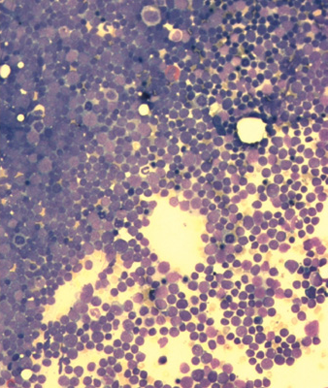Acute Lymphoblastic Leukemia Responds to Immunotherapy
A single cycle of blinatumomab resulted in complete minimal residual disease response in 78% of patients with acute lymphoblastic leukemia.
Acute lymphoblastic leukemia smear; source: Wikimedia Commons, Jimjamjak

A single cycle of the CD19-based immunotherapy blinatumomab resulted in complete minimal residual disease (MRD) response in 78% of patients with acute lymphoblastic leukemia (ALL). A complete MRD response occurred in 80% of patients throughout the course of blinatumomab therapy. The results of the international phase II BLAST trial were presented at the 2014 American Society of Hematology (ASH) Annual Meeting, held December 6–9 in San Francisco.
“Persistent minimal residual disease leads to a very poor prognosis in ALL patients,” said presenter and lead study author Nicola Gökbuget, MD, of Goethe University Hospital in Frankfurt, Germany, at a press conference. Patients with MRD after induction therapy, even those who achieved a hematologic complete remission, have a higher relapse rate compared with those with no MRD, even after a stem cell transplant.
“New approaches are needed to improve outcomes in patients with persistent or recurrent minimal residual disease,” said Gökbuget.
The BLAST trial tested whether blinatumomab can achieve a complete MRD response after a single cycle in 116 ALL patients with a hematologic complete remission who have not had a prior allogeneic stem cell transplant. All patients received a single cycle of the immunotherapy and were then assessed for MRD and continued on trial for up to three subsequent blinatumomab cycles. Follow-up of the trial will assess whether elimination of MRD translates to long-term survival.
Blinatumomab is a “new treatment principle,” said Gökbuget. The drug consists of a CD19-directed antibody linked to a CD3-directed antibody portion. The agent is a part of a new class of bispecific T-cell engagers (BiTEs) that elicit an immune response against tumor cells. CD19 is highly expressed on B-cell tumors, including ALL, while CD3 is a T-cell co-receptor that is required for T-cell activation. Blinatumomab brings CD19-positive ALL cells to T-cells to direct cell-specific lysis of these cells.
The most common adverse events were flu-like systems (fatigue, pyrexia, chills) and gastrointestinal symptoms (diarrhea, nausea, vomiting). Seven percent of patients had a grade 3 or higher fever. Twenty-nine percent of patients had tremors and 13% had aphasia. These neurologic events were clinically relevant, according to Gökbuget.
A 39-patient immunotherapy trial of children with relapsed, refractory ALL resulted in a complete remission in 92% (36) of the patients. The patients were treated with CTL019, a T-cell therapy engineered with a chimeric antigen receptor (CAR) targeted to CD19. The results were presented at a press conference at ASH by Stephan Grupp, MD, PhD, of the Children’s Hospital of Philadelphia and the University of Pennsylvania.
Dr. Grupp discusses the trial.
Fifteen of the patients are still alive after 1 year, and three have gone on to a stem cell transplant. Ten of the patients have relapsed, five with CD19-positive disease and five with CD19-negative disease.
T-cells are collected from each patient, engineered to express the CAR protein against CD19, and then administered back into the patient where the now-activated T-cells target CD19-positive malignant B-cells. So far, over 130 patients with hematologic cancers have been treated.
A significant risk for patients is cytokine-release syndrome, an on-target toxicity that can be reversed, according to Grupp. “We see persistence of the T-cells, which, I think, is the key for patients to remaining in remission.”
Highlighting Insights From the Marginal Zone Lymphoma Workshop
Clinicians outline the significance of the MZL Workshop, where a gathering of international experts in the field discussed updates in the disease state.
